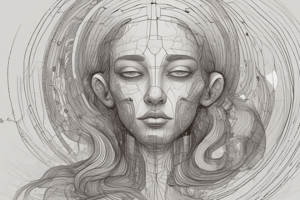Podcast
Questions and Answers
Which of the following is a defining characteristic of Contemporary Art?
Which of the following is a defining characteristic of Contemporary Art?
- Often incorporates elements of technology and digital tools. (correct)
- Primarily focuses on religious themes and symbolism.
- Emphasizes traditional techniques and materials.
- Relies heavily on representational and realistic styles.
What is the primary focus of the "Appropriation" element within Contemporary Art?
What is the primary focus of the "Appropriation" element within Contemporary Art?
- Using only traditional art materials.
- Expressing personal emotions through abstract forms.
- Reinterpreting existing images and ideas for new meanings. (correct)
- Creating realistic depictions of everyday life.
Which of the following art forms is NOT a primary form of Contemporary Art mentioned in the text?
Which of the following art forms is NOT a primary form of Contemporary Art mentioned in the text?
- T’nalak Weaving
- Installation Art (correct)
- Performance Art
- Integrative Art
Which of these is a characteristic of the T’nalak Weaving from Mindanao?
Which of these is a characteristic of the T’nalak Weaving from Mindanao?
What is the significance of the "bulul" in Cordillera Woodcarving?
What is the significance of the "bulul" in Cordillera Woodcarving?
Flashcards
Modern Art
Modern Art
Art created during the late 19th to mid-20th century.
Contemporary Art
Contemporary Art
Art from the late 20th century to now.
Appropriation in Art
Appropriation in Art
Borrowing existing images or ideas to create new meanings.
Integrative Art
Integrative Art
Signup and view all the flashcards
T’nalak Weaving
T’nalak Weaving
Signup and view all the flashcards
Study Notes
Modern Art
- Created during the late 19th century to mid-20th century.
Contemporary Art
- Art from the late 20th century to the present.
Elements of Contemporary Art
- Appropriation: Borrowing existing images or ideas to create new meanings.
- Hybridity: Combining different media and cultural influences.
- Technology: Using digital tools and electronics.
- Performance: Art expressed through actions.
- Space: Transforming environments.
Order of National Artist
- The highest recognition given to Filipino artists who significantly contributed to the arts.
Main Forms of Contemporary Arts
- Visual Arts:
- Pop Art
- Word Art
- Conceptual Art
- Installation Art
- Photorealism
- Contemporary Realism
- Graffiti Art
- Performance Arts:
- Music (blues, electronic, experimental, funk, hip-hop, jazz, metal, pop, rock, roots)
- Theater (stage, film, street play)
- Dance (flash mob, street dances, hip-hop, funk, house, rave)
- Applied Arts:
- Video Art
- Photography
- Computer Art
- Film and Broadcasting Art
- Architecture, Design and Allied Art
- Literary Arts:
- Illustrated Novel
- Digi-Fiction
- Graphic Novels
- Manga
- Doodle Fiction
- Text-Talk Novels
- Chick Literature
- Flash Fiction
- Hyper Poetry -Blog
Integrative Art
- Combining different art forms into a cohesive expression.
T'nalak Weaving (Mindanao)
- A traditional fabric made by the T'boli people.
- Its patterns represent dreams and stories.
Painting
- Expression of ideas and emotions through shapes, lines, colors, tones, and textures.
- The first Philippine paintings were commissioned during the Spanish colonization.
- Paintings are done in Luzon, Visayas, and Mindanao.
Sculpture
- Three-dimensional art objects made from hard or plastic materials.
- Filipino sculptors gained recognition in the mid-19th century.
- Examples are from Luzon, Visayas, and Mindanao.
Architecture
- The art and practice of designing and constructing buildings (simple, rational, and functional)
- Filipino artists introduced the neoclassic style. Real estate development started after World War II.
Film
- A form of visual art using moving images to imitate experiences, communicate ideas, stories, and emotions.
- The Philippine film industry started in 1897.
- Common themes include: Martyrs wife, superhero, action, melodramas, and comedies
Literature.
- Written material including poetry, drama, fiction, nonfiction, journalism, and song.
- Examples from Luzon, Visayas, and Mindanao.
Music
- A collection of coordinated sounds.
- Filipino music has adopted 20th-century art music styles and entertainment industry trends.
Dance
- Movement of the body in a rhythmic way using music or to express an idea or emotion.
- Dances in the Philippines vary from region to region.
Order of National Artists
- Recognizes Filipino artists who made significant contributions to the cultural heritage of the country and achieved excellence.
- Criteria: National Citizenship, Filipino sense of nationhood, creative expression or style, achievements in the practice of art, international or national recognition.
- Example list of recognized artists by category (Architecture, Dance, Film, Literature, Music, Theater, Visual Arts).
Gawad sa Manlilikha ng Bayan
- A prestigious recognition for Filipino traditional artists who passed down indigenous art forms.
- It is awarded to artists who excelled in and preserve traditional arts.
- Criteria for artists: Practice of traditional art significant to a community; artistic skill, mastery; Passing down their skills.
Challenges of Traditional Artists
- Modernization and industrialization.
- Declining interest from younger generations.
- Lack of government and financial support.
Regional Efforts to Promote Indigenous Arts
- Local festivals, cultural programs.
- Workshops, training centers.
- Government support for traditional artists.
Studying That Suits You
Use AI to generate personalized quizzes and flashcards to suit your learning preferences.




